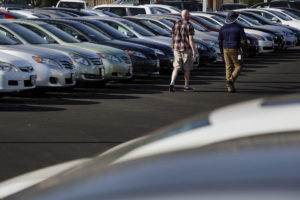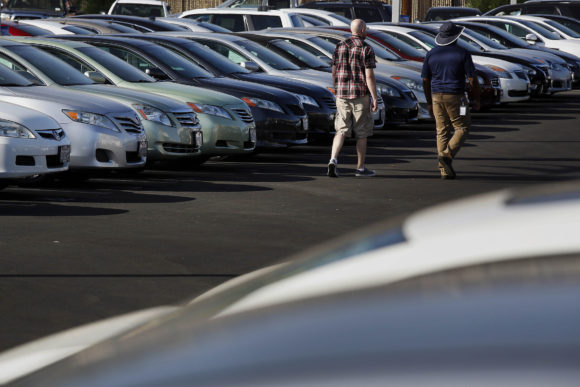Millennials, countless surveys will tell you, are not fans of big banks. They are smart, price-sensitive consumers who are far more likely than older customers to switch lenders if they find a better deal. They are also a huge, irresistible demographic for the financial industry, which is why banks do everything possible to ensure that these digitally native customers stay loyal once they’ve pinched their noses and opened accounts. That means sophisticated social media, nimble mobile-banking platforms, and—in a bid to gain some fintech street cred—a new end-to-end car-buying service by Chase that can be accessed via smartphone. (Or, if you’re old-school, by computer.)
“Many banks are not terribly well-prepared for the mobile, on-the-go, millennial consumer,” said Jeff Fromm, president of marketing consultancy FutureCast. The vast majority of senior people running banks are over the age of 50 and probably not very representative of the population at large, he said.
But they’re trying. This latest offering from Chase, the U.S. consumer and commercial banking arm of JPMorganChase & Co., is in partnership with digital car-buying service TrueCar. Called Chase Auto Direct, it layers auto financing onto online car shopping: Approved borrowers that applied via smartphone or computer are routed to a network of Chase-affiliated dealerships that have the car they want; they walk in to find their paperwork ready. Chase Auto Direct is available for Chase customers in 30 states and will roll out to all 50 states next year.
“The reality is that customers are shopping for everything online, even cars,” said Bruce Jackson, head of retail lending at Chase Auto Finance. “By pairing online financing with the car-buying experience, we can deliver pre-approved customers to our dealers and dramatically simplify the car-buying process.”
The stakes are high, said Nora Ganim Barnes, a professor and director of the Center for Marketing Research at the University of Massachusetts-Dartmouth. “This is not dissimilar to the challenge of newspapers, or of bar soap right now,” she said. “There are lots of things millennials haven’t taken to as their parents did.”
As banks look at the transition of wealth that’s about to take place, they are scrambling to figure out how to capture those young consumers, said Paul Angone, the author of two books whose website, allgroanup.com, focuses on the 18-to-35 demographic. He labels much of the financial industry’s attempts as reactive, rather than thoughtful. The key for Chase will be in the execution, he said. Millennials don’t have a lot of patience for something that turns out to be clunky: “If it doesn’t work, it will generate a ton of negative feelings.”

When it comes to cars, millennials have started to buy, but they’re more deliberate and frugal than their elders, said Steve Szakaly, chief economist at the National Automobile Dealer’s Association. (The average new car buyer is 52 years old and makes about $80,000.) More millennials will break down eventually, he said—perhaps when they discover that a diaper box doesn’t fit on the back of a bike, for example.
While the soup-to-nuts online car buying idea isn’t new, the scale may be. USAA has an online car-buying service that works with TrueCar, letting its members choose and finance a vehicle with the option of getting insurance, too. Unlike USAA, Chase serves about 14,000 dealerships in the U.S. through its indirect auto lending business—meaning it lends to the dealer, which then lends to you, tacking a few basis points onto the interest rate.
Chase’s dealer network may take issue with being cut out, but the bank stresses that the service will be a big lead generator—and sellers get a fee for closing deals. “Customer financing at their dealerships will continue to be popular, and that won’t change anytime soon,” said Jackson. “But we want to be ready for where customers might be down the road.”
A majority of the checking customers Chase picked up last year—57 percent—were millennials. As everyone knows, they live on their phones. Almost 80 percent of Chase’s millennial audience use its mobile banking app, vs. 38 percent of those age 36 and up, said Patricia Wexler, a bank spokesperson. With this in mind, last year Chase paired with OnDeck Capital to offer an online lending platform for small-business clients that it said would shorten approval and funding time to about one day vs. a month or more.
The bank is also dominating another traditional fintech space, generating over $13 billion in person-to-person payments through its QuickPay fund-transfer option during the first six months of 2016, up 40 percent year over year, Wexler said.
“Millennials are an important segment to secure long-term growth, but they’re challenging, both because of their attitudes toward banking and their low levels of aggregate and individual wealth relative to the boomer cohort that they’re expected to replace,” said Lawrence Desmangles, a senior partner at Boston Consulting Group. “The goal of securing deep, loyal, multi-product relationships with these consumers remains elusive.”
A car-buying smartphone option could help keep millennial consumers engaged with Chase—potentially deepening the relationship and making it more likely they will consider it their primary bank. Historically, the more accounts someone has with a financial institution, the more likely they are to stay with them. In bank-speak, they’re “sticky.”
Topics Auto
Was this article valuable?
Here are more articles you may enjoy.



 Experian: AI Agents Could Overtake Human Error as Major Cause of Data Breaches
Experian: AI Agents Could Overtake Human Error as Major Cause of Data Breaches  Warburg Mulls $1 Billion Sale of London Insurance Broker McGill
Warburg Mulls $1 Billion Sale of London Insurance Broker McGill  Expense Ratio Analysis: AI, Remote Work Drive Better P/C Insurer Results
Expense Ratio Analysis: AI, Remote Work Drive Better P/C Insurer Results  Supreme Court Rejects Challenge to $2.46B Boy Scouts Sex Abuse Settlement
Supreme Court Rejects Challenge to $2.46B Boy Scouts Sex Abuse Settlement 

